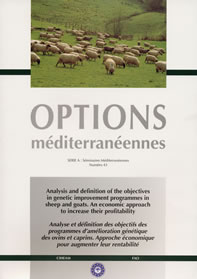| Article précédent | p. 37-40 | Article suivant |
Definition of the breeding objective of the Greek dairy prolific ewes
In Greece, the breeding objective is defined as the improvement of milk production with lamb as a by-product. Milk is usually processed to cheese. The lambs are slaughtered after a suckling period of 42 days at an average live weight of 14 kg. The total revenues of the farm and the relative importance of milk and meat vary among the different production systems and breeds. Data from the Agricultural Research Station of Chalkidiki were analysed, where the income is derived from the sales of milk and slaughtered lambs, from male and female lambs and rams with high genetic merit to other farmers for reproduction purposes. Moreover, data available from private farms were taken into account. Milk recording is carried out in 45 farms counting 5400 head. However, there is no recording on milk composition, somatic cells, economic indexes, health and functional traits. The results of the present study show that the milk sold contributes about 40 per cent of the total income, while lambs sales for meat are lower than 10 per cent and sales from reproduction animals are about 50 per cent. Regarding private farms, the contribution of milk and meat sales to the total income is 70 per cent and 30 per cent, respectively, depending on the production level of the farm.
- [ Afficher ]
- [ Télécharger ]
- [ Exporter la citation ]
Vous pouvez télécharger la citation au format :
- [ Imprimer ]
-
Mots-clés
CRITERE DE SELECTION, GENETIQUE, OVIN, PERFORMANCE DE REPRODUCTIONCiter cet article
Ligda C., Georgoudis A.G., Gabriilidis G.H. Definition of the breeding objective of the Greek dairy prolific ewes. In : Gabiña D. (ed.). Analysis and definition of the objectives in genetic improvement programmes in sheep and goats. An economic approach to increase their profitability . Zaragoza : CIHEAM, 2000. p. 37-40. (Options Méditerranéennes : Série A. Séminaires Méditerranéens; n. 43). Meeting of the Sub-Network on Genetic Resources of the FAO-CIHEAM Inter-Regional Cooperative Research and Development Network on Sheep and Goats, 1999/11/18-20, Zaragoza (Spain). http://om.ciheam.org/om/pdf/a43/00600465.pdf



